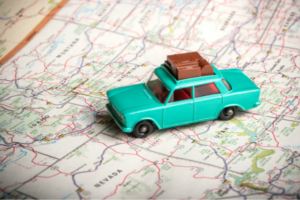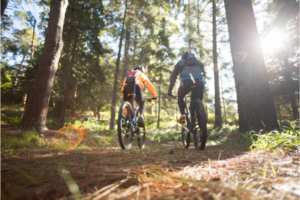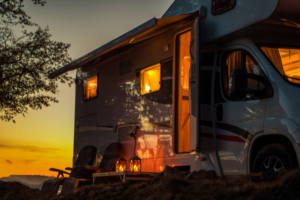I like to travel. I also like to sleep. Unfortunately, the two don’t always go together.
I’m Molly, a digital nomad. I live and work full time from the comfort of my RV, and I know a little something about how to sleep well while traveling.
It may seem odd, but even when you’re exhausted on the road, you have to plan a good night’s sleep and take steps to make sure it happens. You’ve got an itinerary for your road trip, so why not have an itinerary for your slumber, too?
How to Sleep Well While Traveling
For me, a typical travel day (and night) looks something like this.
6 a.m. Rise and shine

I don’t actually get up at 6 a.m. every day, but I am consistent: I make sure to be up a half-hour after sunrise, whenever that happens. There are two reasons for this. First, I don’t want to lose any daylight (I love adventure, and I like to take pictures). Second, I don’t want to mess up my sleep cycle.
Consistency is a watchword if you want to keep your body clock running on schedule. And to do that, you need to be aware of your circadian rhythm, which helps you fall asleep at night and wake up in the morning.
6:30 a.m. Breakfast
It’s important to get fueled up for the day, which is why breakfast is my favorite meal. I like a healthy breakfast that includes sleep-friendly foods like fresh fruit (my favorites are pineapple and kiwi), scrambled eggs, and low-fat, low-sugar yogurt. It’s easy to just grab junk food on the road. But your body will regret it, and so will your pocketbook. As it turns out, “comfort food” isn’t all that comfortable.
7 a.m. Plan the day

If I haven’t already mapped out my schedule for the day, this is when I do so. My boyfriend and I make sure our trip’s all set before we head out to start on a new adventure. That includes getting our ride serviced, checking the tires and the oil, and making sure the brakes are good. We’ve got a huge road trip checklist to ensure we don’t forget anything — or regret anything we’ve forgotten later.
We set a basic itinerary whenever we start a specific adventure, which means mapping everything out on GPS and researching wherever we plan to go. This includes gas prices, where we want to stop, and where we want to stay. But we leave some room for improvisation too. We don’t want to be so stressed out about getting where we’re going that we miss the fun along the way.
7:15 a.m. Get on the road
The daily planning just takes a few minutes to get our bearings and make sure we don’t have to make any last-minute adjustments. We’ve loaded up traffic and weather apps for just that reason: so we can avoid sticky (and slippery situations), congested areas, road work, and, yes, toll roads.
You may be asking, “What does all that have to do with sleep?” A lot, really. The fewer headaches you have, the less stress you’ll have, and the better night’s sleep you’ll get.
10 a.m. and 3 p.m. Stop for exercise

Sitting for too long behind the wheel or in the passenger’s seat can make you sore, and exercise is a great way to set the stage for a good night’s sleep. We try to stop mid-morning and again midafternoon to break things up. It might be for a half-hour hike or a bike ride (we’ve got our bikes racked up on our RV).
Exercise breaks up the monotony of the day, and the afternoon session keeps us from falling victim to the afternoon sleepies, as we call them. Naps sound great in theory, but we both tend to conk out for an hour or two, which puts us behind schedule and interferes with our nighttime sleep quality. Yeah, we could set an alarm, but do we want to? That’s a big no.
By the way, 3 p.m. is also our caffeine cutoff time.
Noon
More healthy food for lunch. It’s not a big meal, just enough to replenish the old energy cells.
6 p.m.

We try to stop for the night a couple of hours before sunset because we’ve got stuff to do before we sleep. Dinner’s first on the agenda: This is what we call our pro-veg meal: protein and vegetables.
Then it’s time to wind down. We make sure we do everything we need to do on our phones before sunset because staring at blue light after dark is one of the worst things you can do to keep yourself awake and mess up your sleep cycle.
That doesn’t mean we’re anti-phone, though. Since we both work from the road, we rely on connectivity. That means we’ve got a backup generator (CARB-compliant, of course: we’re big on the environment) to keep the lights on, a cell booster to keep us “in range,” and extra power cords to recharge, just in case.
7 p.m.
I’m using 7 p.m. as a synonym for sunset here. This is when we start to wind down. We both love to read, so that is how we usually spend our evenings.
Occasionally, we will splurge on a massage to help ease the aches and pains of constant driving. Besides, a good massage can boost serotonin levels and reduce cortisol, a stress-induced hormone, which can help you sleep. We’ve also learned the benefits of essential oils in conjunction with massage to ease muscle aches.
9 p.m

This is when we typically bed down for the night. (Neither one of us drinks much, which is a good thing because we learned alcohol can help you get to sleep but also ruins your sleep quality.)
We’re prepared, too, because we know that even the slightest irritation can ruin a good night’s rest. We never leave home without a fan for the warmer nights and mummy bags for the cold ones, and we’ve got blackout curtains to keep out any stray light.
We also take our favorite comforter for maximum softness and our favorite pillows to keep our necks from getting sore. I use a white noise app on my phone to drown out sounds from a nearby highway or the occasional snoring fit from my partner.
So there you have it: A typical travel day for us. It goes to show that a good night’s sleep isn’t just about what happens after the lights go out; it’s something you prepare for all day long.
Bio: Molly Barnes is a full-time digital nomad, exploring and working remotely in different cities in the US. She and her boyfriend Jacob created the website Digital Nomad Life to share their journey and help others pursue a nomadic lifestyle.

